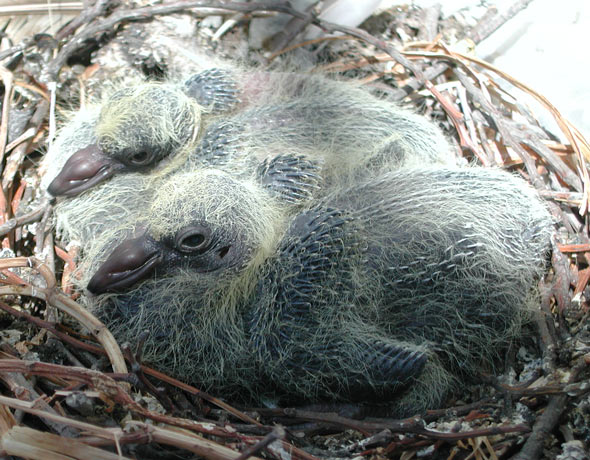Why Do We Never See Baby Pigeons?

Where did all the baby pigeons go?
Turns out the wriggling baby songbirds are just waiting in their nests until they mature enough to flit about on their own. (Songbirds are birds that belong to the scientific Order Passeriformes, which are more commonly known as "perching" birds.)
"I always find it interesting why people wonder about not seeing baby pigeons, but don't wonder the same thing about any other birds," said Marc Devokaitis, public information specialist at the Cornell Lab of Ornithology in New York. "Really the only birds we typically see the babies of are the waterfowl. The reason is simple: Most baby songbirds are in the nest until they are fully feathered and as big as the adults."
However, to be fair, there are a few reasons for such infrequent sightings of baby rock pigeons (Columba livia), in particular: Their nests tend to be out of view, on rooftops and other skyscraping venues such as bridges and the sides of high-rises; pigeons spend a longer time as nestlings than other birds; and pigeon babies grow up at least appearance-wise faster than other birds, Devokaitis said. [101 Animal Shots You'll Go Wild Over]
"Before the advent of the man-made cliffs and canyons that typify the modern metropolis, wild rock pigeons used caves and rocky fissures of montane or coastal cliffs," Devokaitis told Live Science. "The only requirement is that the surface is flat and covered to some extent."
And so even if fledging pigeons do hop out of their nests, they'd still be out of view for passersby on the ground, whereas other songbirds with less lofty nests might be seen on the ground or sitting on a bush shortly after they fledge, according to Devokaitis.
Pigeon young do get a little spoiled, though. Whereas most songbirds spend two to three weeks in the nest, pigeons hang out for at least three weeks and up to six weeks in the comfort of the mom's quarters, Devokaitis said.
Get the world’s most fascinating discoveries delivered straight to your inbox.
By that time, the juvenile pigeons look more like adults than other birds when they leave the nest, she said.
If you keep an eye out though, you may be able to spot these young'uns: Look for feathers that aren't completely molted, dark eyes (adults have red-orange eyes) and tapered primary feathers (the longest feathers on the bird's wing), Devokaitis said.
Original article on Live Science.
Jeanna Bryner is managing editor of Scientific American. Previously she was editor in chief of Live Science and, prior to that, an editor at Scholastic's Science World magazine. Bryner has an English degree from Salisbury University, a master's degree in biogeochemistry and environmental sciences from the University of Maryland and a graduate science journalism degree from New York University. She has worked as a biologist in Florida, where she monitored wetlands and did field surveys for endangered species, including the gorgeous Florida Scrub Jay. She also received an ocean sciences journalism fellowship from the Woods Hole Oceanographic Institution. She is a firm believer that science is for everyone and that just about everything can be viewed through the lens of science.




